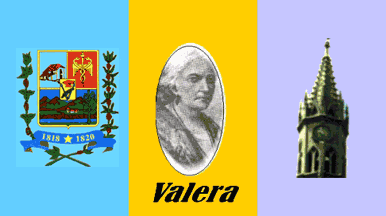
by Jens Pattke, 5 August 2004

Last modified: 2014-05-22 by zoltán horváth
Keywords: trujillo | valera |
Links: FOTW homepage |
search |
disclaimer and copyright |
write us |
mirrors
See also:
Other sites:
Attributes and Semiology: According the consulted source,
consists in three stripes: Sky-blue, gilded and tenuous Violet
(lily). Completes the design the image of a lady
accompanied by the word "VALERA" to the center on the
gilded stripe and the Municipal Coat of Arms to the canton
on the sky- blue stripe. The sky-blue symbolizes balance,
faith, happiness, divine force and the Valerian sky being
reflected on the waters that run by the drains and fountains
which spilled on Momboy river located in the middle of the valley
where was born Doctor and Colonel Antonio Nicolas Briceño,
hero of the Independence of Venezuela, on April 29th,1782 in
"La Concepción" (The Conception) estate located on
Mendoza Parish of this Municipality. The gilded stripe alludes to
the crucible of pure gold assayed in intelligence,
illumination, wisdom, constance, dedication, work and prosperity
for the inhabitants of the locality, who day to day make an
effort by its development; on the one hand and by the other,
reminds the wealth produced by the fertile ground of the
Municipality thanks to the hard task which the humble farmer
makes for obtain optimal agricultural products. The violet stripe
indicates mercy, simplicity, humility, solidarity, candor and
honor. The image remembers the distinguished and noble matron
Doña Mercedes Diaz de Terán, who donate part of its property
"Santa Rita" (Saint Rita) for the construction of the
church and then town of Valera, whose name also appears inscribed
for emphasize the name of the current city and for demonstrate
the importance of its past, present and future. The Municipal
Coat of Arms on the canton is the reaffirmation of the identity
and values of the Municipality. It's necessary to mention that
the preceding image is a basic reconstruction of the design
previously described.
Historical Synthesis: Until the moment of the redaction of this
file is not available data about the origin and official adoption
of this flag.
Coat of Arms - Attributes: According to the description obtained
of the consulted source, consist in a field divided per fess, the
chief per pale. The Dexter Quarter of the Chief shows an old
colonial house. The Sinister Quarter of the Chief presents a
caduceus. The Quarter of the Base shows a landscape where
rebounds seven hills, a river, a prairie and a sugar cane
plantation. Over all, an escutcheon charged with a hammer, an
anvil, a pen and a compass. As external ornament, the blazon
shows a pennant that loads the ephemeris "1818" and
"1820". It necessary to mention that the
consulted source doesn't present some image of this Coat of Arms.
Semiology: The First Quarter emphasizes the historical house
denominated "Carmania" which belonged to the Patriot
and Illustrious Saint Francisco Antonio Rosario, native of
Trujillo but adoptive son of Mendoza where he lived and died on
July 31st, 1847: place which El Libertador Simón Bolivar used
for rest in his trips through Venezuelan Andes. The Second
Quarter presents a caduceus, emblem of Mercury, the Medicine and
Commerce, with which it wishes to emphasize the importance of
the last one in the happening of the locality. The Third
Quarter alludes to the local geography whose landmarks are the
valleys, the mountains and the sowing grounds watered by Momboy
river. In the escutcheon, the anvil and the hammer symbolizes the
work, whereas the pen and the compass alludes to the culture and
the spiritual duty. The pennant raises the more important
historical dates of the Municipality.
Historical Synthesis: It was created by Dr. Pedro Emilio Carrillo
Sources: Web Sire Mayorship of Valera at <www.municipiovalera.gov.ve>,
located by Pablo Acosta Ríos, 31 July 2003.
Raul Orta, 26 May 2004
t-vl.jpg)
from <valera-trujillo.gov.ve>